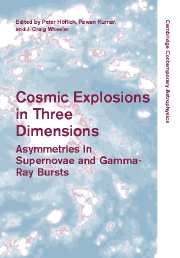Book contents
- Frontmatter
- Contents
- Part I Introduction
- Part II Supernovae: Observations Today
- Part III Theory of Thermonuclear Supernovae
- Part IV Theory of Core Collapse Supernovae
- Part V Magnetars, N-Stars, Pulsars
- 30 Supernova remnant and pulsar wind nebula interactions
- 31 X-ray signatures of supernovae
- 32 Neutron star kicks and supernova asymmetry
- 33 Triggers of magnetar outbursts
- 34 Turbulent MHD jet collimation and thermal driving
- 35 The interplay between nuclear electron capture and fluid dynamics in core collapse supernovae
- Part VI Gamma-ray Bursts
- Part VII Conference Summary
- References
32 - Neutron star kicks and supernova asymmetry
Published online by Cambridge University Press: 11 August 2009
- Frontmatter
- Contents
- Part I Introduction
- Part II Supernovae: Observations Today
- Part III Theory of Thermonuclear Supernovae
- Part IV Theory of Core Collapse Supernovae
- Part V Magnetars, N-Stars, Pulsars
- 30 Supernova remnant and pulsar wind nebula interactions
- 31 X-ray signatures of supernovae
- 32 Neutron star kicks and supernova asymmetry
- 33 Triggers of magnetar outbursts
- 34 Turbulent MHD jet collimation and thermal driving
- 35 The interplay between nuclear electron capture and fluid dynamics in core collapse supernovae
- Part VI Gamma-ray Bursts
- Part VII Conference Summary
- References
Summary
Abstract
Observations over the last decade have shown that neutron stars receive a large kick velocity (of order a few hundred to a thousand km s-1) at birth. The physical origin of the kicks and the related supernova asymmetry is one of the central unsolved mysteries of supernova research. We review the physics of different kick mechanisms, including hydrodynamically driven, neutrino — magnetic field driven, and electromagnetically driven kicks. The viabilities of the different kick mechanisms are directly related to the other key parameters characterizing nascent neutron stars, such as the initial magnetic field and the initial spin. Recent observational constraints on kick mechanisms are also discussed.
Evidence for neutron star kicks and supernova asymmetry
It has long been recognized that neutron stars (NSs) have space velocities much greater than their progenitors'. A natural explanation for such high velocities is that supernova (SN) explosions are asymmetric, and provide kicks to the nascent NSs. Evidence for NS kicks and NS asymmetry has recently become much stronger. The observations that support (or even require) NS kicks fall into three categories:
Large NS Velocities (≫ the progenitors' velocities ∼30 km s-1):
The study of pulsar proper motion give a mean birth velocity 200–500 km s-1 (Lorimer et al. 1997; Hansen & Phinney 1997; Cordes & Chernoff 1998; Arzoumanian et al. 2002), with possibly a significant population having V ≳ 1000 km s-1. While velocity of ∼100 km s-1 may in principle come from binary breakup in a supernova (without kick), higher velocities would require exceedingly tight presupernova binary.[…]
- Type
- Chapter
- Information
- Cosmic Explosions in Three DimensionsAsymmetries in Supernovae and Gamma-Ray Bursts, pp. 276 - 284Publisher: Cambridge University PressPrint publication year: 2004
References
- 13
- Cited by



